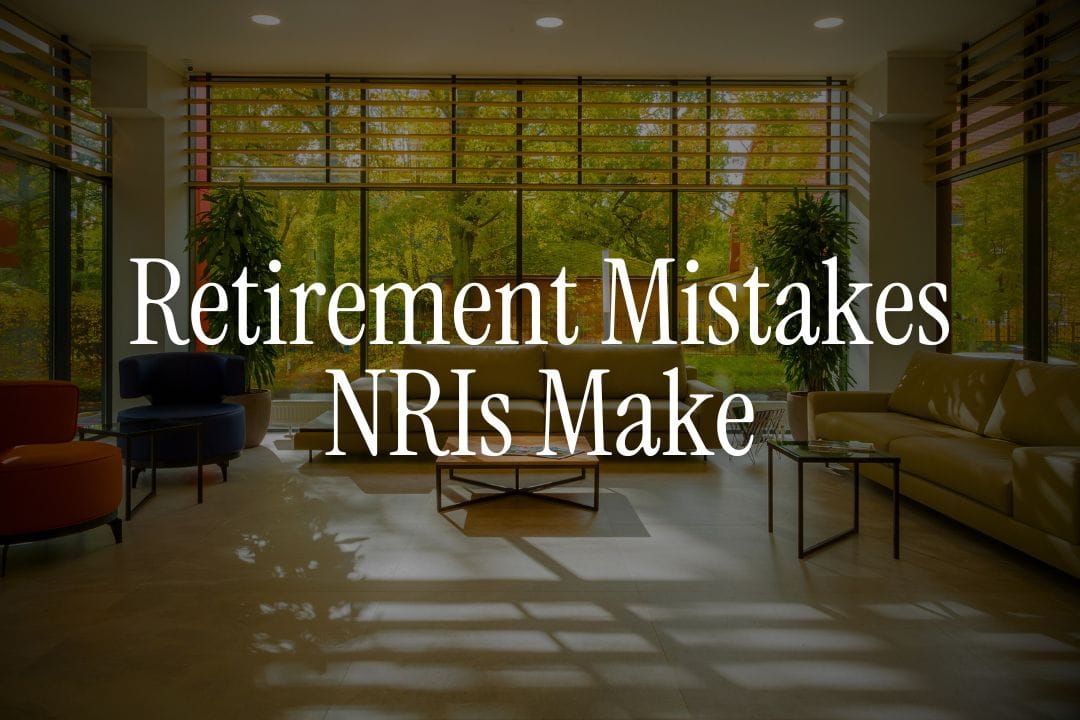
We've seen this story unfold too many times - an NRI couple returns to India after 20 years in Dubai, only to receive a ₹15 lakh tax notice six months later for "unreported global income."
Another client liquidated their entire 401(k) before returning, triggering a 30% tax hit they could have avoided. At Belong, we've guided over 5,000 NRIs through their return journey, and honestly, the same mistakes keep repeating.
The difference between a smooth homecoming and a financial nightmare often comes down to understanding a few critical rules that nobody explains clearly.
This guide walks you through the 7 most expensive mistakes NRIs make when returning to India - from the RNOR status confusion that could save you lakhs in taxes, to the healthcare gaps that catch everyone off guard, to the property decisions that haunt you years later.
Mistake #1: Misunderstanding Your Tax Residency Status (This One Costs Lakhs)
The RNOR Status Goldmine Most NRIs Miss
Here's what happened to Rajesh, who returned from California in April 2024. He assumed that since he was back in India, all his US stock dividends and rental income would now be taxed in India. He mentally prepared for a massive tax bill.
What he didn't know?
He qualified for RNOR (Resident but Not Ordinarily Resident) status, meaning his foreign income remained tax-free in India for up to 3 years.
The confusion around residential status costs NRIs more money than any other mistake. Let's break this down simply:
You become a Resident of India if:
- You stay 182 days or more in India during the financial year, OR
- You stay 60 days in the current year + 365 days in the past 4 years
But here's the game-changer: If you've been an NRI for 9 out of the last 10 years, you automatically qualify for RNOR status when you return. According to Section 6 of the Income Tax Act, this means:
- Your Indian income is taxable (like rent from your Bangalore property)
- Your foreign income stays tax-free (US dividends, Dubai rental income, overseas interest)
- This benefit lasts for up to 3 years after your return
👉 Critical tip: Track your days meticulously. Landing on March 29 vs April 2 can change your entire tax situation for the year. Use our Residential Status Calculator to know exactly where you stand.
The 120-Day Trap for High Earners
Here's a lesser-known rule that catches successful NRIs: If you're an Indian citizen/PIO earning over ₹15 lakhs from Indian sources (rent, FD interest, dividends), staying just 120 days in India can trigger residency - not the usual 182 days.
We had a client from Dubai who owned three rental properties in Mumbai generating ₹22 lakhs annually.
He visited India for his daughter's wedding, stayed 125 days, and boom - became an RNOR instead of remaining an NRI. While RNOR is still beneficial, it changed his compliance requirements completely.
Mistake #2: Getting Hit by Double Taxation (When It's Completely Avoidable)
Why NRIs Pay Tax Twice on the Same Income
Sarah worked for Microsoft in Seattle and had substantial 401(k) withdrawals and US rental income.
When she returned to India in 2024, she paid US taxes on these incomes and then received an Indian tax notice for the same amounts. Total tax burden? Nearly 45%.
What she missed: India has Double Taxation Avoidance Agreements (DTAA) with 96 countries, including the US, UK, UAE, Singapore, and Canada. These treaties ensure you don't pay tax twice on the same income.
How DTAA actually works:
- Tax Credit Method: Pay tax in one country, claim credit in the other
- Exemption Method: Income taxed only in one country
- Reduced Tax Rates: Special rates for dividends, interest, royalties
Real example: US Social Security benefits are taxable only in the US under India-USA DTAA Article 20. Your 401(k) distributions get treaty benefits under Article 21. Without claiming these, you're literally donating money to the government.
Documents You Need for DTAA Claims
Missing even one document means losing DTAA benefits:
- Tax Residency Certificate (TRC) from your foreign country
- Form 10F submitted to Indian payer
- Form 67 when filing Indian returns
- Foreign tax payment proof
👉 Money-saving move: Start collecting these documents 6 months before returning. Getting a TRC from the US can take 8-12 weeks. The UAE process is faster but requires personal appearance.
Mistake #3: Banking Compliance Disasters That Trigger Penalties
Not Converting NRE/NRO Accounts = FEMA Violation
This is the silent killer. According to RBI regulations, you MUST convert your NRE/NRO accounts to resident accounts within reasonable time after returning.
"Reasonable time" isn't defined, but based on FEMA violation cases we've seen, banks start flagging after 6 months.
What happens to each account type:
- NRE Account: Must convert to resident savings account or RFC (Resident Foreign Currency) account
- NRO Account: Converts to regular resident account
- FCNR Deposits: Can hold until maturity, then must convert proceeds
One client kept his NRE account active for 2 years after returning, thinking the tax-free interest was a smart move.
Result?
₹5 lakh FEMA penalty plus the account was frozen, creating a cascade of bounced EMIs and credit score damage.
The RFC Account Secret Weapon
Here's what most articles won't tell you: Open an RFC account before converting your NRE account. An RFC account lets you:
- Hold foreign currency legally as a resident
- Earn better interest than regular savings
- Repatriate funds if you become NRI again
- No limit on balance or repatriation
We've seen NRIs park $500,000+ in RFC accounts, earning 4-5% interest while maintaining currency flexibility.
Mistake #4: Healthcare Coverage Gaps That Cost Fortunes
Your International Insurance Is Now Worthless
That comprehensive Cigna or Aetna plan covering you globally?
The moment you become an Indian resident, most international insurers exclude India from coverage or drastically limit it. We've seen NRIs discover this during medical emergencies, facing ₹20 lakh hospital bills they assumed were covered.
The insurance transition timeline:
- Before returning: Buy Indian health insurance with waiting periods starting
- First year back: Overlap international and Indian coverage
- Year 2 onwards: Full Indian coverage kicks in
Indian Healthcare Insurance Reality Check
Indian health insurance works differently than Western systems:
- Pre-existing conditions: 2-4 year waiting periods as per IRDAI regulations
- Room rent limits: Many policies cap room rent, affecting overall claim
- Disease-wise sub-limits: Cataract surgery might be capped at ₹40,000
- Co-payment clauses: You pay 10-20% of claims after age 60
👉 Smart move: Buy a ₹1 crore family floater + ₹50 lakh top-up. Combined premium: ₹35,000-₹50,000 annually. Covers most medical scenarios including critical illnesses.
Corporate Insurance Buffers You're Losing
If you had employer coverage abroad, you're losing more than you realize:
- Dental coverage (rarely covered in India)
- Mental health support (limited coverage)
- Preventive health checkups (once a year max)
- International emergency evacuation (not covered)
Build a healthcare fund of at least ₹10 lakhs specifically for uncovered expenses in your first 2 years back.
Mistake #5: Property and Investment Chaos
The Great NRI Property Paperwork Mess
You bought properties as an NRI, and now you're a resident. Here's what changes and what doesn't:
What stays the same:
- Property ownership rights
- Ability to sell to anyone
- Rental income generation
What changes completely:
- TDS on property sale drops from 30% to 20% (long-term gains)
- Repatriation rules for sale proceeds
- Rental income taxation at slab rates instead of flat 30%
- Need to update property records with new residential status
Investment Account Nightmares
Your US brokerage, UK ISA, or Singapore CPF needs attention:
US Brokerage Accounts: Most US brokers (Charles Schwab, Vanguard, Fidelity) restrict or close accounts once you're not a US resident. Interactive Brokers is one exception. Start transferring positions 6 months before returning.
Indian Investment Accounts: Your NRI demat account must convert to resident status. This isn't automatic - you need to submit fresh KYC with major brokers. Missing this means blocked trading and corporate action benefits.
The 401(k) Optimization Strategy: Don't withdraw your entire 401(k)! Keep it invested in the US, take systematic withdrawals after age 59½. Under India-US DTAA, these distributions get favorable tax treatment. One client saved ₹43 lakhs in taxes over 5 years using this approach versus lump sum withdrawal.
Mistake #6: Underestimating India's Real Cost of Living
The Lifestyle Inflation Trap
"India is cheap" - until you try maintaining Western standards. Here's what NRIs consistently underbudget:
Metropolitan reality check (Mumbai/Delhi/Bangalore):
- International school fees: ₹6-15 lakhs per year per child
- Reliable domestic help: ₹50,000-₹70,000 monthly (cook, driver, cleaner)
- Organic groceries: 2-3x regular prices
- Dining at "expat-friendly" restaurants: ₹3,000-₹5,000 per meal
- Diesel generator/inverter backup: ₹2,000-₹3,000 monthly maintenance
- Water purification systems: ₹50,000 installation + ₹500 monthly
- Air purification: ₹1 lakh for whole-house systems
A Dubai-based family of four moving to Gurgaon budgeted ₹1.5 lakhs monthly. Actual expenses? ₹2.8 lakhs maintaining similar lifestyle standards.
Hidden India Costs Nobody Mentions
Social obligations: Weddings gifts (₹11,000-₹51,000 each), festival celebrations, extended family support. Budget ₹3-5 lakhs annually.
Medical tourism reverse: NRIs often fly abroad for major procedures due to trust issues. Singapore medical trip: ₹5-10 lakhs including travel.
Vacation inflation: Those Thailand/Dubai trips now cost more due to rupee depreciation. Annual vacation budget: ₹5-8 lakhs for a family.
👉 Reality check: Plan for expenses 50% higher than estimated in year one. Use our community insights where returning NRIs share actual expense breakdowns city-wise.
Mistake #7: No Estate Planning for Cross-Border Assets
The Inheritance Mess You're Creating
Indian succession laws don't automatically recognize foreign wills. Your meticulously planned US will covering global assets? Might be worthless for Indian property.
The two-will strategy:
- Foreign will for foreign assets
- Indian will for Indian assets
- Mirror clauses to avoid conflict
- Professional translation and attestation
The Succession Certificate Nightmare
Without proper documentation, your heirs face:
- 6-12 month succession certificate process
- Court fees of 3-7% of asset value
- Multiple NOCs from legal heirs
- Separate procedures for each asset class
One NRI's family spent 3 years and ₹12 lakhs in legal fees settling assets across India, US, and UK because of inadequate planning.
Cross-border estate planning essentials:
- Update nominee details on all accounts within 30 days of return
- Create separate wills for each jurisdiction
- Register Indian will (optional but recommended)
- Maintain asset inventory with access credentials
- Appoint executors familiar with both country laws
Your 90-Day Action Plan After Landing
Days 1-30: Immediate Compliance
- File Intimation of return to banks holding NRE/NRO accounts
- Apply for Indian health insurance
- Update KYC on investment accounts
- Calculate RNOR status eligibility
Days 31-60: Financial Restructuring
- Open RFC account if holding foreign currency
- Convert NRE/NRO accounts
- Update property records
- Collect DTAA documentation
Days 61-90: Long-term Setup
- Execute Indian will
- Complete investment account transitions
- Finalize insurance coverage
- Establish healthcare relationships
Why These Mistakes Keep Happening
After helping thousands of NRIs return, we've noticed patterns. The information exists but it's scattered across 50 different government websites, written in legalese, with conflicting interpretations.
Banks give different advice than CAs. CAs disagree with each other. Meanwhile, you're trying to manage this across time zones while wrapping up life abroad.
The good news? Every mistake mentioned here is preventable with proper planning. Start 6 months before your return date, not after landing.
How We Help at Belong
Our team has been through this journey - we understand the complexity firsthand. Through our WhatsApp community, returning NRIs share real experiences, costs, and solutions. No judgment, just practical help from people who've been there.
Our tools like the Residential Status Calculator and Compliance Compass cut through confusion with simple answers. And our advisors? They've handled every scenario mentioned above and more.
The difference between a stressful return and a smooth transition often comes down to having the right guidance at the right time. Download our app for personalized planning or join our community to learn from others navigating the same journey.
Remember: Returning to India after years abroad is more than a financial transition - it's a life transition. Give yourself grace, plan thoroughly, and don't hesitate to seek expert help. The cost of good advice is fraction of what these mistakes could cost you.
Have specific questions about your return journey?
Drop them in our WhatsApp community where our team and fellow NRIs can provide personalized insights based on real experiences.




